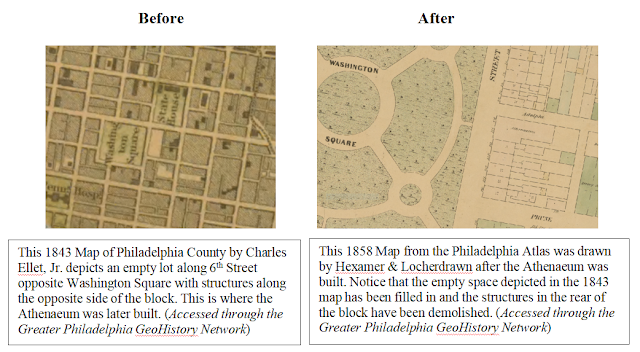Building Name: The Athenaeum of Philadelphia
Street Address: 219 South 6th Street, Philadelphia, PA 19106
Architect: John Notman (1810-1865)
Year Opened: 1845
Purpose: The Athenaeum is a private, member supported research library, museum, and archive chartered to provide useful knowledge for the benefit of the public.
The Athenaeum is a dramatic and inspiring Italianate building with a long history as a Philadelphia landmark. The exteriors and the interiors of the building reveal a great deal about the building’s character and importance when it was built. That significance endures to this day as it continues to be an inspiring and useful space for researchers, historians, and architects.
INTRODUCTION:
At that time the Athenaeum was built, Philadelphia was beginning to transition from home-based work shops to an industrial metropolis. Because of social and economic conditions, Philadelphians formed many organizations. In this way, the Athenaeum was likely conceived of as a way to store and access important information.
The development of the building site can be viewed in the following maps:
Interestingly, the Athenaeum was built across two different properties. In the map from 1843, there is an undeveloped lot along 6th Street, but there are other structures on the block. Around the time the Athenaeum was built, those structures were demolished, as seen by their absence in the 1858 map.
It was probably decided that the building should be somewhere important. Likewise, they probably wanted to build somewhere accessible for members. Because Washington square was a prominent location and centrally located relative to the city developments taking place in 1840s Philadelphia, this site appears to be the most logical choice.
DESCRIPTION:
Plan: The Athenaeum is arranged in an asymmetrical hierarchy. The hallway forms a primary axis with the front door. A narrower hallway forms a perpendicular secondary axis with the side door on St. James Plaza. The first floor plan can be seen in the Architectural drawing below:
On the first floor, the stairwell forms an asymmetrical space that branches off from the hallway in the center of the building. The stairwell leads to an alcove on the second floor and the impressive library. The library takes up most of the building on the second floor and has 25 foot high ceilings.
Style: The Athenaeum is an Italianate style building, as seen in the photographs throughout this paper. In the first two photos, the building’s exterior is made of masonry and the corners of the building are resolved with rusticated quoins. The exterior and interior doors and windows pictured below are framed by overhanging eaves with large, embellished brackets. The interior ceilings pictured below also have decorative cornices accented with dentals. However, the most recognizable Italianate features are the high ceilings and large windows on the second floor.
Circulation: In plan, the transitional spaces provide access to different rooms. However, architectural emphasis lends them more importance:
Main Spaces: There is a hierarchy of significance throughout the Athenaeum. One of the important spaces on the first floor is this modest reading room:
However, the impressive library is revealed on the second floor opposite an adjoining room. Both spaces have tall and decorated walls, ceilings, and fixtures:
Patterns: The interiors, especially floors and ceilings, use rich geometric patters to accent the space:
Materials: While interiors are made of wood, the clever use of faux surfacing dramatically increases the decorative material palette available:
On the exteriors, the real materials are observable, but still richly decorated with ornament:
Color and Texture: The interior architecture of the Athenaeum uses a rich and varied color palette that is accented by the sculptural textures in the cornices, entablatures, and ceilings:
Ornamentation: There are many functional components of the architecture and interiors that are also decorated with ornaments:
IMPRESSION
The Athenaeum felt inspiring and uplifting. My favorite room was the library because of its’ bright colors, decorations, textures, and the sheer magnitude of scale. I also felt that the approach to the library was surprising, because nothing in the stairwell, hallways, or exterior hinted that the library would be so grand. I also noticed that it was very quiet inside the building as a whole, making it easier to concentrate.
CONCLUSION
Everything about the Athenaeum reflects it’s dual nature as both a functional space to store and access information as well as a place to surprise and impress. The location provides easy access for membership, but is also a statement of importance. Likewise, the interiors have many practical features, ranging from air vents to columns, but they are embellished in ways that make them important. The most lasting impression of all is the element of surprise encoded in the architecture, as experienced through the elegant ascent into the spacious and brightly decorated library. Perhaps all these characteristics were meant to increase membership. Perhaps it was simply meant to inspire. Whatever the case, the Athenaeum is an example of exquisite architecture that functions well and inspires beautifully.
RESOURCES:
“Historic American Buildings Survey: Philadelphia Athenaeum" Prints; Digital Online Catalog, Library of Congress, 1999, www.loc.gov/pictures/item/pa1092.sheet.00001a/.
Greater Philadelphia GeoHistory Network, 2019. http://www.philageohistory.org



















No comments:
Post a Comment